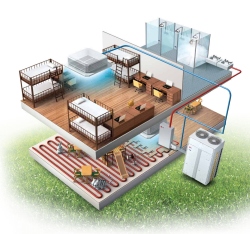Putting VRF air conditioning at the heart of energy efficiency

Not only is VRF air-conditioning equipment becoming ever-more efficient at its main task, but the integration of ways to use its reject heat further improve overall energy efficiency. Lee Snook of LG explains how.
Air conditioning equipment is, like most technologies these days, advancing in leaps and bounds with functionality and performance — whilst seeing equivalent advances in the ease of installation and ease of use. The advances we are seeing relate to the all-round environment — energy efficiency, noise, air quality and, at the same time, being easier to monitor and control. The demand is being seen across all applications large and small, heating and cooling.
Domestic air conditioning is still a relatively small marketplace in the UK. Whilst many people still associate air conditioning with cooling only, today’s home air-conditioning systems also heat with the use of highly energy-efficient heat-pump technology. In turn, bedrooms, conservatories and loft conversions that are typically too hot to be comfortable in the summer and difficult to keep warm in the winter can be enjoyed at a constant level throughout the year.
There is also a growing demand for air-to-water heat pumps for heating and hot water, where COPs of up to 4.5 can be found. That means for example 1 kW of input power generates up to 4.5 kW of output power, even with outdoor ambient temperatures of -2°C
In commercial applications where the air-conditioning system also doubles up as the heating system, We have developed an efficient way to recover waste heat from a VRF air-conditioning system and use it cost effectively and energy efficiently to provide heating and hot water for areas such as kitchens, bathrooms, radiators and underfloor heating systems.
 |
| Hot water produced from heat rejected by air conditioning has a host of uses. |
VRF solutions are widely considered to be among the most versatile and powerful system air conditioners available. Providing exceptional comfort, energy efficiency and reliability, they are highly regarded by building managers, business operators and HVAC engineers. VRF solutions boast a number of other tangible benefits, including cost effectiveness and easier installation compared to modular systems.
Thanks to significant advancements in HVAC technology, VRF systems are now able to offer unmatched performance capabilities along with reduced energy consumption. Many projects that LG has been involved with have contributed hugely with regards to Part L compliance due to the very high efficiencies that are being achieved.
The main parts of the system to focus on for reducing energy consumption are inverter-driven compressors to increase efficiency at full and part load. Manufacturers look at the compressor for ways to reduce energy consumption as this is the ‘heart’ of an air conditioning system.
For example, the speed of our fourth-generation compressor goes up to 150 Hz — providing rapid response and making a unit capable of reaching the required temperatures quickly and increasing part-load efficiency.
Next, looking at the oil return within a compressor can always reduce the compressor’s energy consumption by a small percentage, known as a hidden energy loss. We achieve this using smart oil return, which measures the presence of oil in real-time and only recovers oil when necessary — improving efficiency of the system and prolonging the operating life of the compressor.
One of the most topical areas currently for VRF installations is the specification of hydro kits to extract heat from a Multi V heat-pump or heat-recovery system to provide domestic hot water.
Rejecting waste heat to atmosphere is becoming a thing of the past. Recovering heat and use it elsewhere in the building is part and parcel of today’s thinking when designing a building, and heat-recovery has reached a level of sophistication where there is always a way of re-using the heat you have already paid for in another application.
 |
| Combining air conditioning with a Hydro Kit (centre) can not only deliver air conditioning but also space heating and domestic hot water. |
Hydro kits provide hot water and underfloor heating using far less than a traditional boiler-driven wet system. In addition, a hydro kit requires no exhaust to the outside of the building as a boiler does.
The hydro kit is compact and easy to install and can connect to multiple heat pumps for additional savings if required.
These systems benefit from cutting-edge controls technology that ensure precise temperature control and no wastage. In addition, HVAC controllers have been developed to reduce a system’s overall energy load. Such controls have huge positive implications for those specifying HVAC equipment.
Lee Snook is national sales manager for air conditioning with LG.








